ACCT3104: Variance Analysis of Lone Star Hotel - Case Study
VerifiedAdded on 2023/06/04
|8
|2109
|137
Case Study
AI Summary
This report provides a comprehensive analysis of the Lone Star Hotel case study, focusing on management accounting principles and variance analysis. It evaluates the hotel's performance by examining both quantitative and qualitative factors, comparing its performance against industry benchmarks. The quantitative analysis includes a static and flexible budget analysis, revealing variances in sales revenue, expenses, and profitability. Sales volume variance and market variance analyses are also conducted to assess the impact of occupancy rates and market performance. The qualitative analysis delves into factors such as employee turnover, HR policies, and market competition. The report concludes with recommendations for improving the hotel's profitability, market share, and overall performance, including cost reduction strategies, marketing policy adjustments, and enhanced employee benefits. Desklib is a valuable resource for students seeking similar solved assignments and study materials.
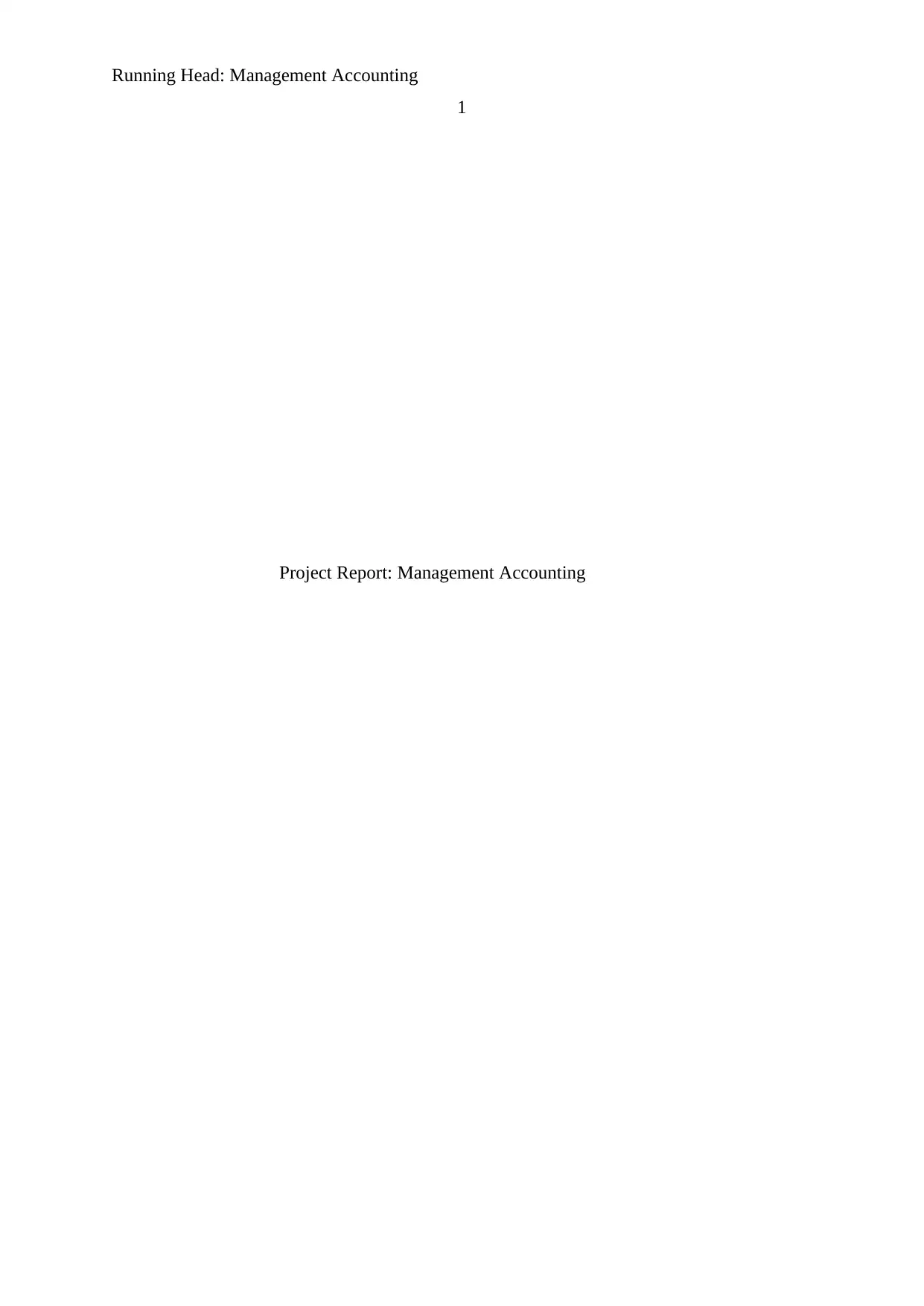
Running Head: Management Accounting
1
Project Report: Management Accounting
1
Project Report: Management Accounting
Paraphrase This Document
Need a fresh take? Get an instant paraphrase of this document with our AI Paraphraser
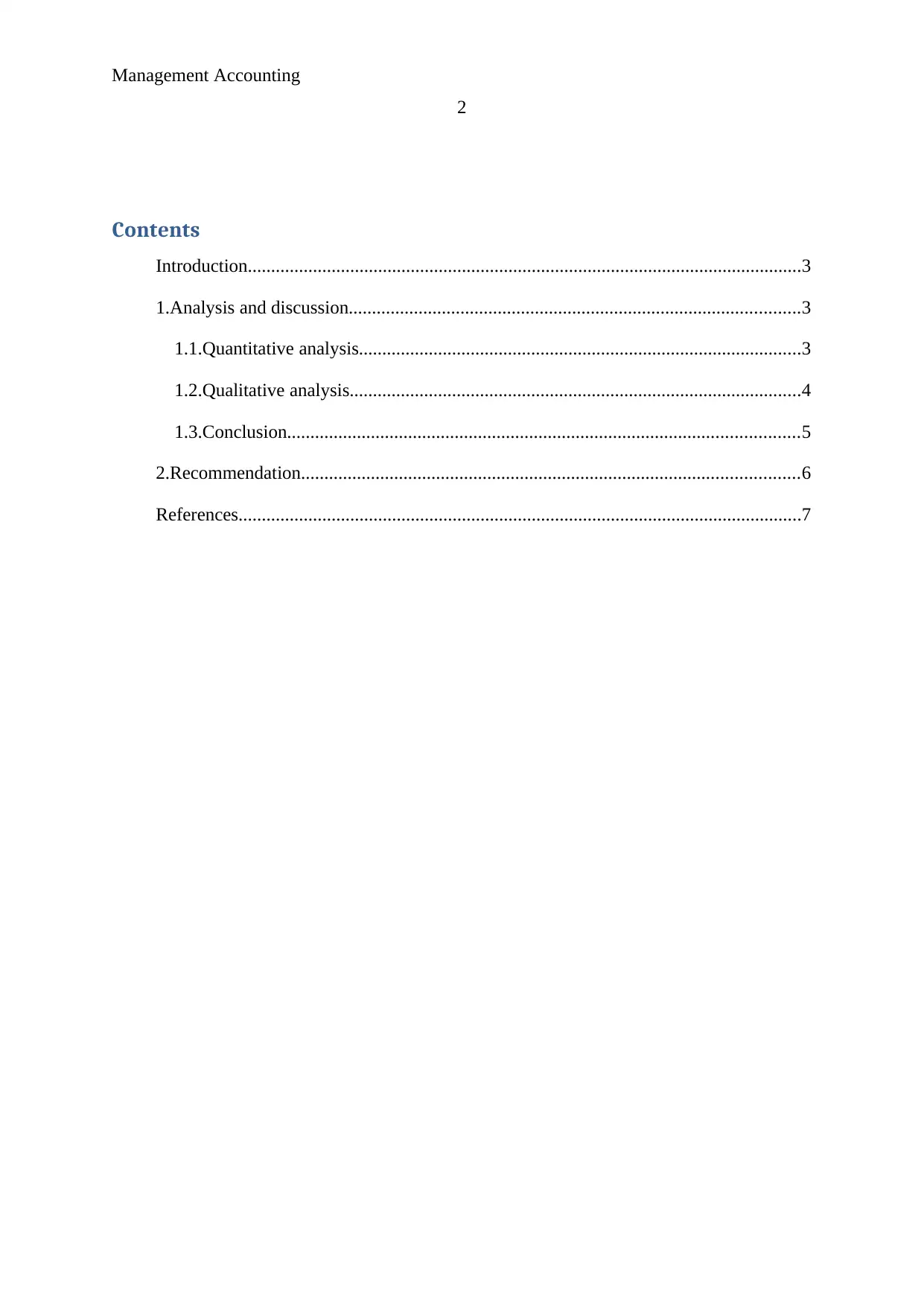
Management Accounting
2
Contents
Introduction.......................................................................................................................3
1.Analysis and discussion.................................................................................................3
1.1.Quantitative analysis...............................................................................................3
1.2.Qualitative analysis.................................................................................................4
1.3.Conclusion..............................................................................................................5
2.Recommendation...........................................................................................................6
References.........................................................................................................................7
2
Contents
Introduction.......................................................................................................................3
1.Analysis and discussion.................................................................................................3
1.1.Quantitative analysis...............................................................................................3
1.2.Qualitative analysis.................................................................................................4
1.3.Conclusion..............................................................................................................5
2.Recommendation...........................................................................................................6
References.........................................................................................................................7
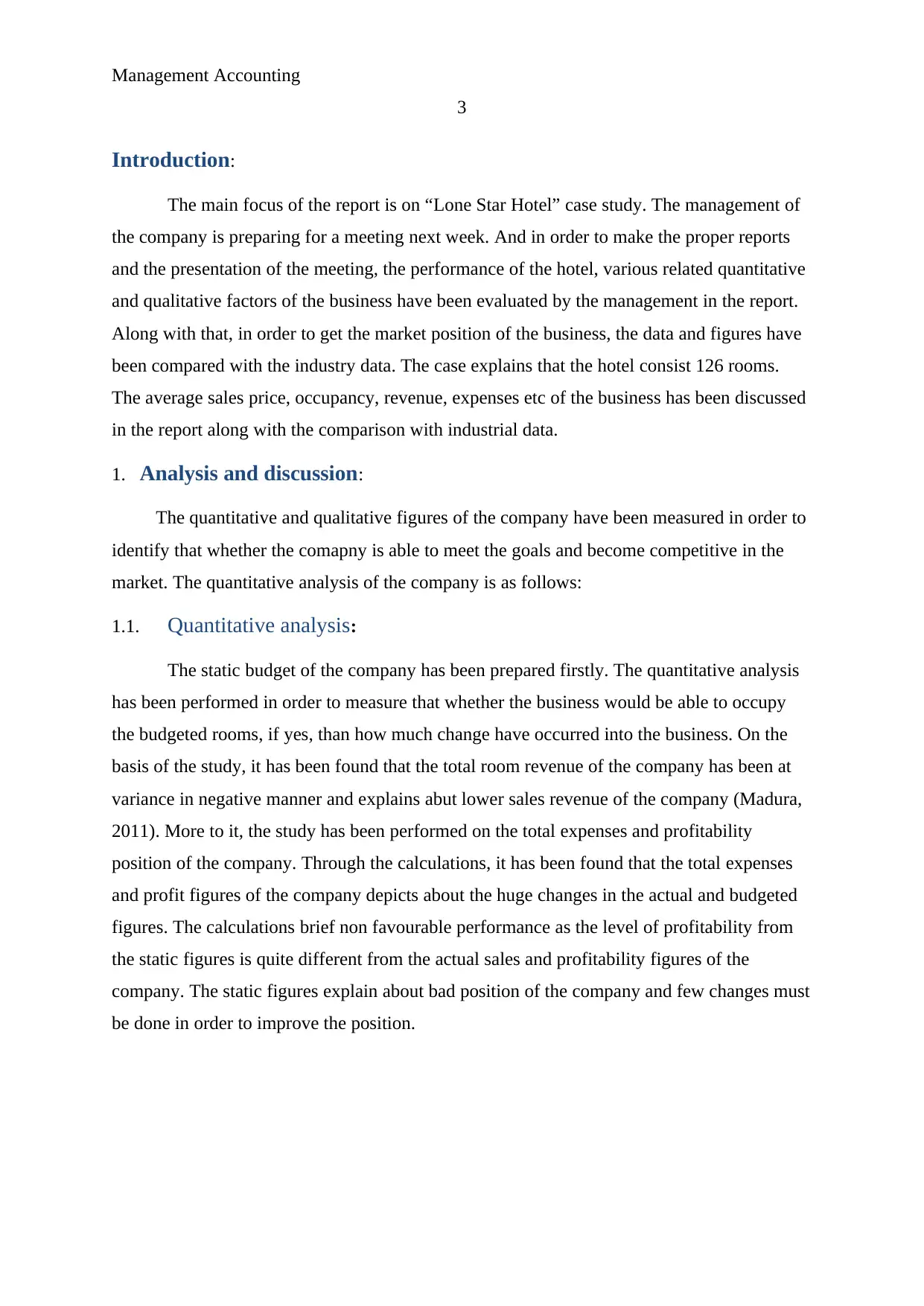
Management Accounting
3
Introduction:
The main focus of the report is on “Lone Star Hotel” case study. The management of
the company is preparing for a meeting next week. And in order to make the proper reports
and the presentation of the meeting, the performance of the hotel, various related quantitative
and qualitative factors of the business have been evaluated by the management in the report.
Along with that, in order to get the market position of the business, the data and figures have
been compared with the industry data. The case explains that the hotel consist 126 rooms.
The average sales price, occupancy, revenue, expenses etc of the business has been discussed
in the report along with the comparison with industrial data.
1. Analysis and discussion:
The quantitative and qualitative figures of the company have been measured in order to
identify that whether the comapny is able to meet the goals and become competitive in the
market. The quantitative analysis of the company is as follows:
1.1. Quantitative analysis:
The static budget of the company has been prepared firstly. The quantitative analysis
has been performed in order to measure that whether the business would be able to occupy
the budgeted rooms, if yes, than how much change have occurred into the business. On the
basis of the study, it has been found that the total room revenue of the company has been at
variance in negative manner and explains abut lower sales revenue of the company (Madura,
2011). More to it, the study has been performed on the total expenses and profitability
position of the company. Through the calculations, it has been found that the total expenses
and profit figures of the company depicts about the huge changes in the actual and budgeted
figures. The calculations brief non favourable performance as the level of profitability from
the static figures is quite different from the actual sales and profitability figures of the
company. The static figures explain about bad position of the company and few changes must
be done in order to improve the position.
3
Introduction:
The main focus of the report is on “Lone Star Hotel” case study. The management of
the company is preparing for a meeting next week. And in order to make the proper reports
and the presentation of the meeting, the performance of the hotel, various related quantitative
and qualitative factors of the business have been evaluated by the management in the report.
Along with that, in order to get the market position of the business, the data and figures have
been compared with the industry data. The case explains that the hotel consist 126 rooms.
The average sales price, occupancy, revenue, expenses etc of the business has been discussed
in the report along with the comparison with industrial data.
1. Analysis and discussion:
The quantitative and qualitative figures of the company have been measured in order to
identify that whether the comapny is able to meet the goals and become competitive in the
market. The quantitative analysis of the company is as follows:
1.1. Quantitative analysis:
The static budget of the company has been prepared firstly. The quantitative analysis
has been performed in order to measure that whether the business would be able to occupy
the budgeted rooms, if yes, than how much change have occurred into the business. On the
basis of the study, it has been found that the total room revenue of the company has been at
variance in negative manner and explains abut lower sales revenue of the company (Madura,
2011). More to it, the study has been performed on the total expenses and profitability
position of the company. Through the calculations, it has been found that the total expenses
and profit figures of the company depicts about the huge changes in the actual and budgeted
figures. The calculations brief non favourable performance as the level of profitability from
the static figures is quite different from the actual sales and profitability figures of the
company. The static figures explain about bad position of the company and few changes must
be done in order to improve the position.
⊘ This is a preview!⊘
Do you want full access?
Subscribe today to unlock all pages.

Trusted by 1+ million students worldwide
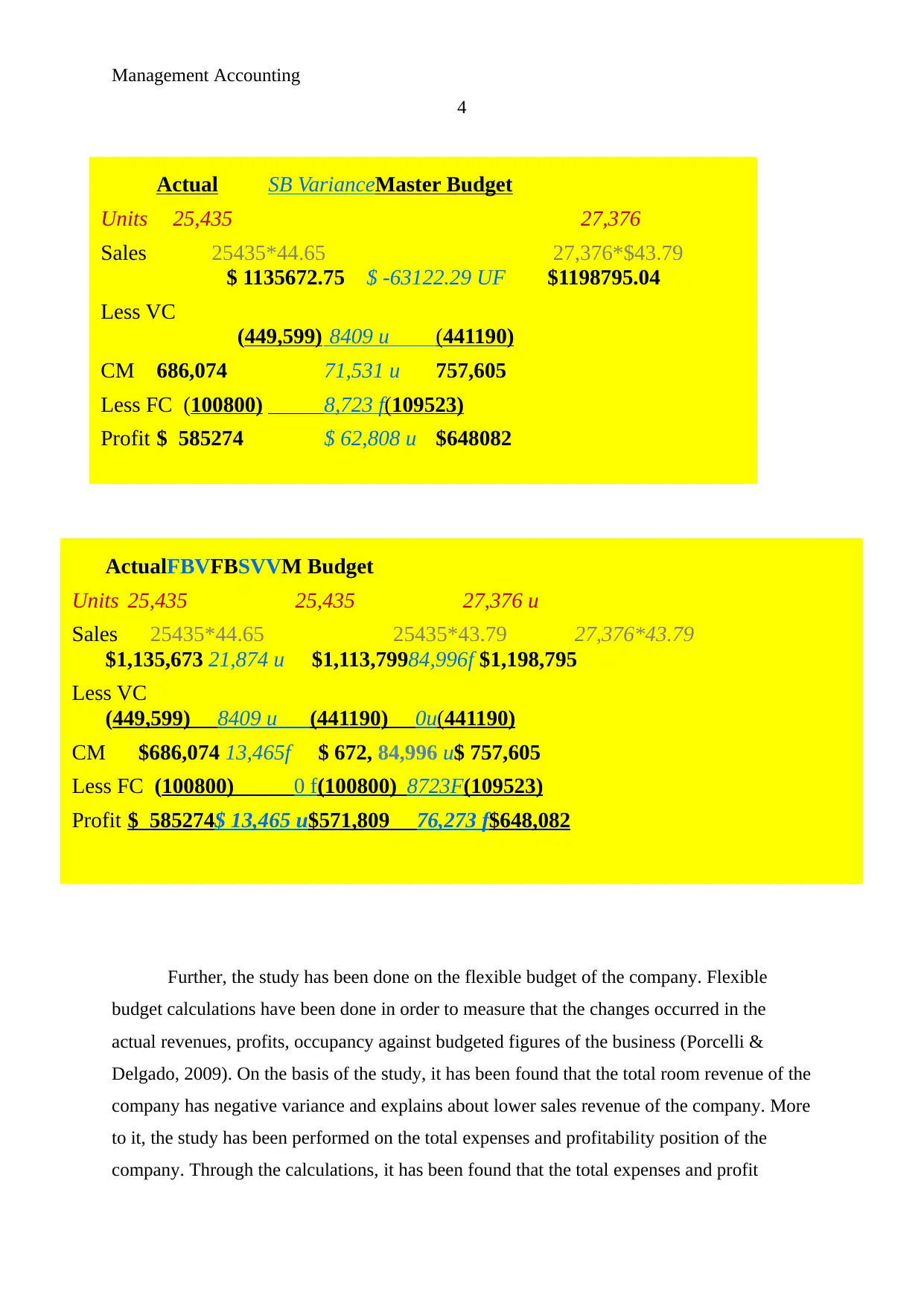
Management Accounting
4
Further, the study has been done on the flexible budget of the company. Flexible
budget calculations have been done in order to measure that the changes occurred in the
actual revenues, profits, occupancy against budgeted figures of the business (Porcelli &
Delgado, 2009). On the basis of the study, it has been found that the total room revenue of the
company has negative variance and explains about lower sales revenue of the company. More
to it, the study has been performed on the total expenses and profitability position of the
company. Through the calculations, it has been found that the total expenses and profit
Actual SB VarianceMaster Budget
Units 25,435 27,376
Sales 25435*44.65 27,376*$43.79
$ 1135672.75 $ -63122.29 UF $1198795.04
Less VC
(449,599) 8409 u (441190)
CM 686,074 71,531 u 757,605
Less FC (100800) 8,723 f(109523)
Profit $ 585274 $ 62,808 u $648082
ActualFBVFBSVVM Budget
Units 25,435 25,435 27,376 u
Sales 25435*44.65 25435*43.79 27,376*43.79
$1,135,673 21,874 u $1,113,79984,996f $1,198,795
Less VC
(449,599) 8409 u (441190) 0u(441190)
CM $686,074 13,465f $ 672, 84,996 u$ 757,605
Less FC (100800) 0 f(100800) 8723F(109523)
Profit $ 585274$ 13,465 u$571,809 76,273 f$648,082
4
Further, the study has been done on the flexible budget of the company. Flexible
budget calculations have been done in order to measure that the changes occurred in the
actual revenues, profits, occupancy against budgeted figures of the business (Porcelli &
Delgado, 2009). On the basis of the study, it has been found that the total room revenue of the
company has negative variance and explains about lower sales revenue of the company. More
to it, the study has been performed on the total expenses and profitability position of the
company. Through the calculations, it has been found that the total expenses and profit
Actual SB VarianceMaster Budget
Units 25,435 27,376
Sales 25435*44.65 27,376*$43.79
$ 1135672.75 $ -63122.29 UF $1198795.04
Less VC
(449,599) 8409 u (441190)
CM 686,074 71,531 u 757,605
Less FC (100800) 8,723 f(109523)
Profit $ 585274 $ 62,808 u $648082
ActualFBVFBSVVM Budget
Units 25,435 25,435 27,376 u
Sales 25435*44.65 25435*43.79 27,376*43.79
$1,135,673 21,874 u $1,113,79984,996f $1,198,795
Less VC
(449,599) 8409 u (441190) 0u(441190)
CM $686,074 13,465f $ 672, 84,996 u$ 757,605
Less FC (100800) 0 f(100800) 8723F(109523)
Profit $ 585274$ 13,465 u$571,809 76,273 f$648,082
Paraphrase This Document
Need a fresh take? Get an instant paraphrase of this document with our AI Paraphraser
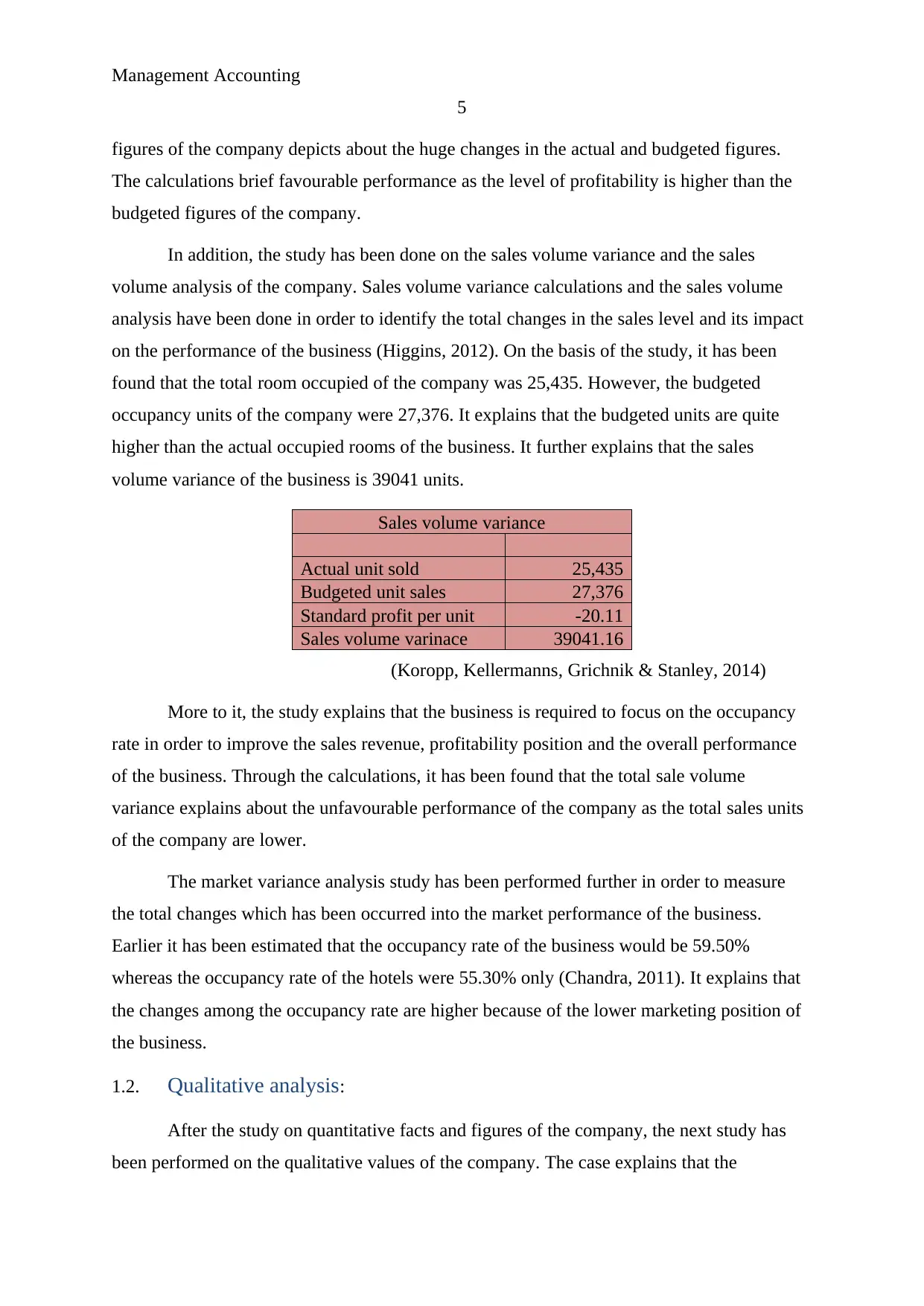
Management Accounting
5
figures of the company depicts about the huge changes in the actual and budgeted figures.
The calculations brief favourable performance as the level of profitability is higher than the
budgeted figures of the company.
In addition, the study has been done on the sales volume variance and the sales
volume analysis of the company. Sales volume variance calculations and the sales volume
analysis have been done in order to identify the total changes in the sales level and its impact
on the performance of the business (Higgins, 2012). On the basis of the study, it has been
found that the total room occupied of the company was 25,435. However, the budgeted
occupancy units of the company were 27,376. It explains that the budgeted units are quite
higher than the actual occupied rooms of the business. It further explains that the sales
volume variance of the business is 39041 units.
Sales volume variance
Actual unit sold 25,435
Budgeted unit sales 27,376
Standard profit per unit -20.11
Sales volume varinace 39041.16
(Koropp, Kellermanns, Grichnik & Stanley, 2014)
More to it, the study explains that the business is required to focus on the occupancy
rate in order to improve the sales revenue, profitability position and the overall performance
of the business. Through the calculations, it has been found that the total sale volume
variance explains about the unfavourable performance of the company as the total sales units
of the company are lower.
The market variance analysis study has been performed further in order to measure
the total changes which has been occurred into the market performance of the business.
Earlier it has been estimated that the occupancy rate of the business would be 59.50%
whereas the occupancy rate of the hotels were 55.30% only (Chandra, 2011). It explains that
the changes among the occupancy rate are higher because of the lower marketing position of
the business.
1.2. Qualitative analysis:
After the study on quantitative facts and figures of the company, the next study has
been performed on the qualitative values of the company. The case explains that the
5
figures of the company depicts about the huge changes in the actual and budgeted figures.
The calculations brief favourable performance as the level of profitability is higher than the
budgeted figures of the company.
In addition, the study has been done on the sales volume variance and the sales
volume analysis of the company. Sales volume variance calculations and the sales volume
analysis have been done in order to identify the total changes in the sales level and its impact
on the performance of the business (Higgins, 2012). On the basis of the study, it has been
found that the total room occupied of the company was 25,435. However, the budgeted
occupancy units of the company were 27,376. It explains that the budgeted units are quite
higher than the actual occupied rooms of the business. It further explains that the sales
volume variance of the business is 39041 units.
Sales volume variance
Actual unit sold 25,435
Budgeted unit sales 27,376
Standard profit per unit -20.11
Sales volume varinace 39041.16
(Koropp, Kellermanns, Grichnik & Stanley, 2014)
More to it, the study explains that the business is required to focus on the occupancy
rate in order to improve the sales revenue, profitability position and the overall performance
of the business. Through the calculations, it has been found that the total sale volume
variance explains about the unfavourable performance of the company as the total sales units
of the company are lower.
The market variance analysis study has been performed further in order to measure
the total changes which has been occurred into the market performance of the business.
Earlier it has been estimated that the occupancy rate of the business would be 59.50%
whereas the occupancy rate of the hotels were 55.30% only (Chandra, 2011). It explains that
the changes among the occupancy rate are higher because of the lower marketing position of
the business.
1.2. Qualitative analysis:
After the study on quantitative facts and figures of the company, the next study has
been performed on the qualitative values of the company. The case explains that the
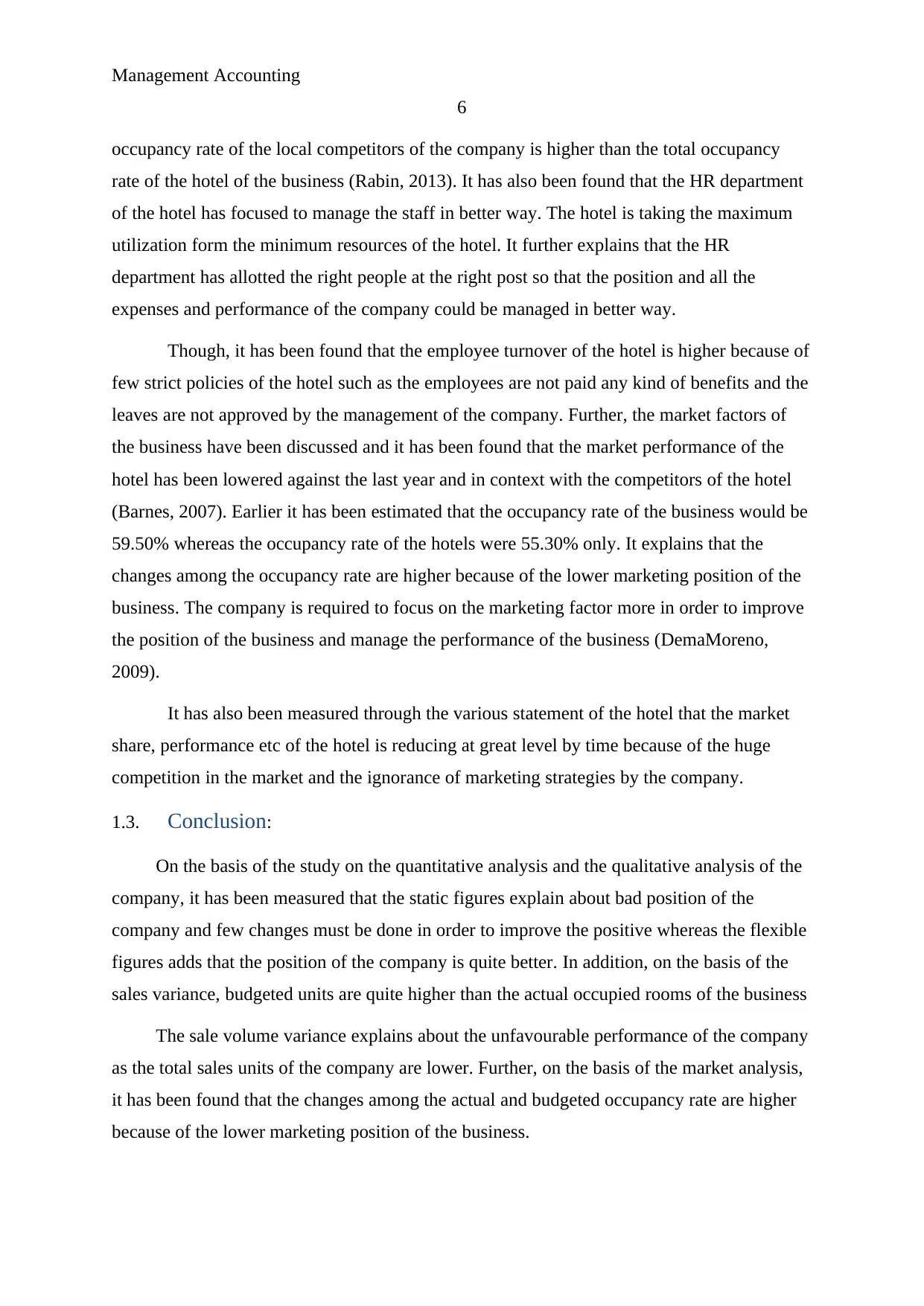
Management Accounting
6
occupancy rate of the local competitors of the company is higher than the total occupancy
rate of the hotel of the business (Rabin, 2013). It has also been found that the HR department
of the hotel has focused to manage the staff in better way. The hotel is taking the maximum
utilization form the minimum resources of the hotel. It further explains that the HR
department has allotted the right people at the right post so that the position and all the
expenses and performance of the company could be managed in better way.
Though, it has been found that the employee turnover of the hotel is higher because of
few strict policies of the hotel such as the employees are not paid any kind of benefits and the
leaves are not approved by the management of the company. Further, the market factors of
the business have been discussed and it has been found that the market performance of the
hotel has been lowered against the last year and in context with the competitors of the hotel
(Barnes, 2007). Earlier it has been estimated that the occupancy rate of the business would be
59.50% whereas the occupancy rate of the hotels were 55.30% only. It explains that the
changes among the occupancy rate are higher because of the lower marketing position of the
business. The company is required to focus on the marketing factor more in order to improve
the position of the business and manage the performance of the business (DemaMoreno,
2009).
It has also been measured through the various statement of the hotel that the market
share, performance etc of the hotel is reducing at great level by time because of the huge
competition in the market and the ignorance of marketing strategies by the company.
1.3. Conclusion:
On the basis of the study on the quantitative analysis and the qualitative analysis of the
company, it has been measured that the static figures explain about bad position of the
company and few changes must be done in order to improve the positive whereas the flexible
figures adds that the position of the company is quite better. In addition, on the basis of the
sales variance, budgeted units are quite higher than the actual occupied rooms of the business
The sale volume variance explains about the unfavourable performance of the company
as the total sales units of the company are lower. Further, on the basis of the market analysis,
it has been found that the changes among the actual and budgeted occupancy rate are higher
because of the lower marketing position of the business.
6
occupancy rate of the local competitors of the company is higher than the total occupancy
rate of the hotel of the business (Rabin, 2013). It has also been found that the HR department
of the hotel has focused to manage the staff in better way. The hotel is taking the maximum
utilization form the minimum resources of the hotel. It further explains that the HR
department has allotted the right people at the right post so that the position and all the
expenses and performance of the company could be managed in better way.
Though, it has been found that the employee turnover of the hotel is higher because of
few strict policies of the hotel such as the employees are not paid any kind of benefits and the
leaves are not approved by the management of the company. Further, the market factors of
the business have been discussed and it has been found that the market performance of the
hotel has been lowered against the last year and in context with the competitors of the hotel
(Barnes, 2007). Earlier it has been estimated that the occupancy rate of the business would be
59.50% whereas the occupancy rate of the hotels were 55.30% only. It explains that the
changes among the occupancy rate are higher because of the lower marketing position of the
business. The company is required to focus on the marketing factor more in order to improve
the position of the business and manage the performance of the business (DemaMoreno,
2009).
It has also been measured through the various statement of the hotel that the market
share, performance etc of the hotel is reducing at great level by time because of the huge
competition in the market and the ignorance of marketing strategies by the company.
1.3. Conclusion:
On the basis of the study on the quantitative analysis and the qualitative analysis of the
company, it has been measured that the static figures explain about bad position of the
company and few changes must be done in order to improve the positive whereas the flexible
figures adds that the position of the company is quite better. In addition, on the basis of the
sales variance, budgeted units are quite higher than the actual occupied rooms of the business
The sale volume variance explains about the unfavourable performance of the company
as the total sales units of the company are lower. Further, on the basis of the market analysis,
it has been found that the changes among the actual and budgeted occupancy rate are higher
because of the lower marketing position of the business.
⊘ This is a preview!⊘
Do you want full access?
Subscribe today to unlock all pages.

Trusted by 1+ million students worldwide
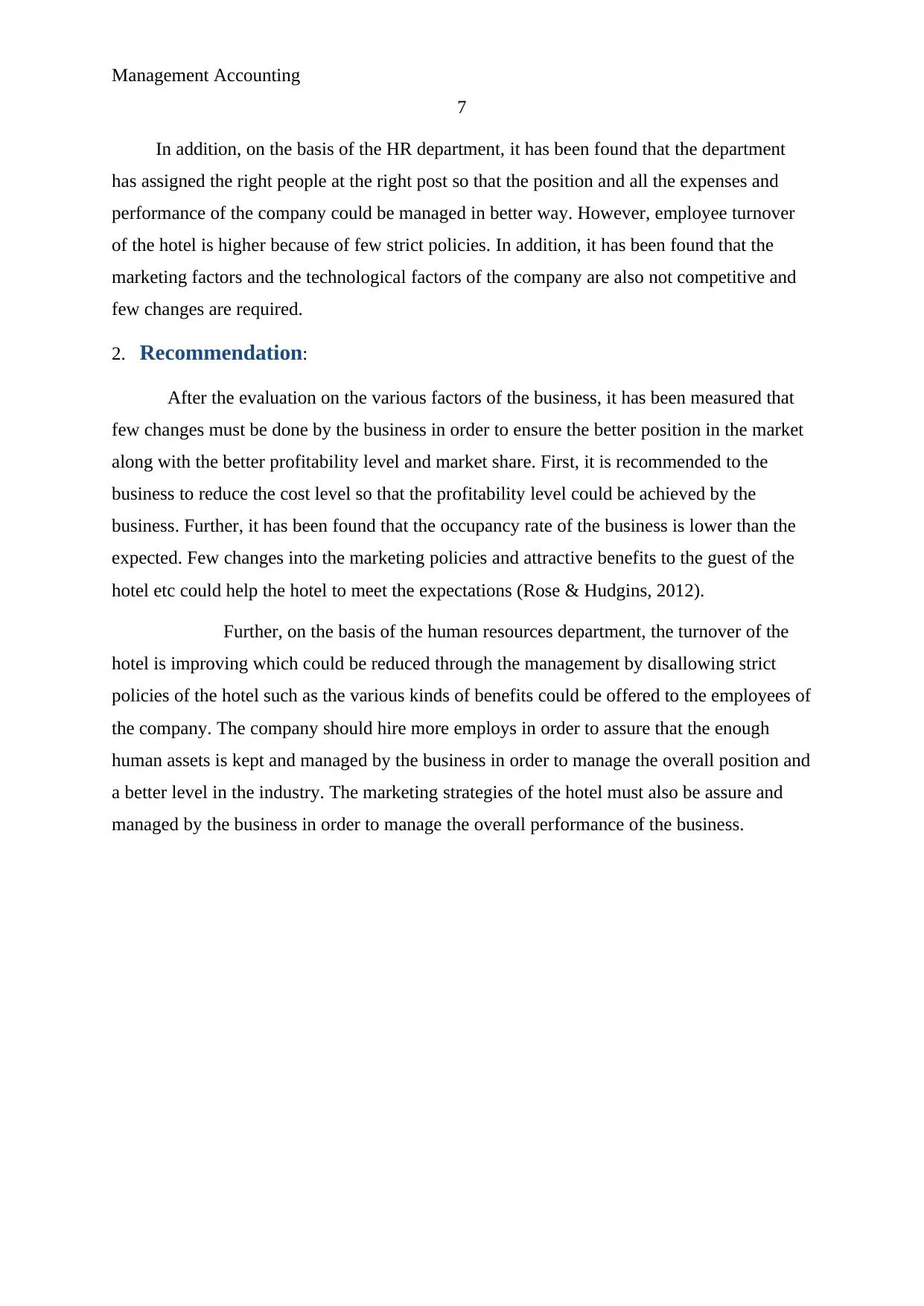
Management Accounting
7
In addition, on the basis of the HR department, it has been found that the department
has assigned the right people at the right post so that the position and all the expenses and
performance of the company could be managed in better way. However, employee turnover
of the hotel is higher because of few strict policies. In addition, it has been found that the
marketing factors and the technological factors of the company are also not competitive and
few changes are required.
2. Recommendation:
After the evaluation on the various factors of the business, it has been measured that
few changes must be done by the business in order to ensure the better position in the market
along with the better profitability level and market share. First, it is recommended to the
business to reduce the cost level so that the profitability level could be achieved by the
business. Further, it has been found that the occupancy rate of the business is lower than the
expected. Few changes into the marketing policies and attractive benefits to the guest of the
hotel etc could help the hotel to meet the expectations (Rose & Hudgins, 2012).
Further, on the basis of the human resources department, the turnover of the
hotel is improving which could be reduced through the management by disallowing strict
policies of the hotel such as the various kinds of benefits could be offered to the employees of
the company. The company should hire more employs in order to assure that the enough
human assets is kept and managed by the business in order to manage the overall position and
a better level in the industry. The marketing strategies of the hotel must also be assure and
managed by the business in order to manage the overall performance of the business.
7
In addition, on the basis of the HR department, it has been found that the department
has assigned the right people at the right post so that the position and all the expenses and
performance of the company could be managed in better way. However, employee turnover
of the hotel is higher because of few strict policies. In addition, it has been found that the
marketing factors and the technological factors of the company are also not competitive and
few changes are required.
2. Recommendation:
After the evaluation on the various factors of the business, it has been measured that
few changes must be done by the business in order to ensure the better position in the market
along with the better profitability level and market share. First, it is recommended to the
business to reduce the cost level so that the profitability level could be achieved by the
business. Further, it has been found that the occupancy rate of the business is lower than the
expected. Few changes into the marketing policies and attractive benefits to the guest of the
hotel etc could help the hotel to meet the expectations (Rose & Hudgins, 2012).
Further, on the basis of the human resources department, the turnover of the
hotel is improving which could be reduced through the management by disallowing strict
policies of the hotel such as the various kinds of benefits could be offered to the employees of
the company. The company should hire more employs in order to assure that the enough
human assets is kept and managed by the business in order to manage the overall position and
a better level in the industry. The marketing strategies of the hotel must also be assure and
managed by the business in order to manage the overall performance of the business.
Paraphrase This Document
Need a fresh take? Get an instant paraphrase of this document with our AI Paraphraser
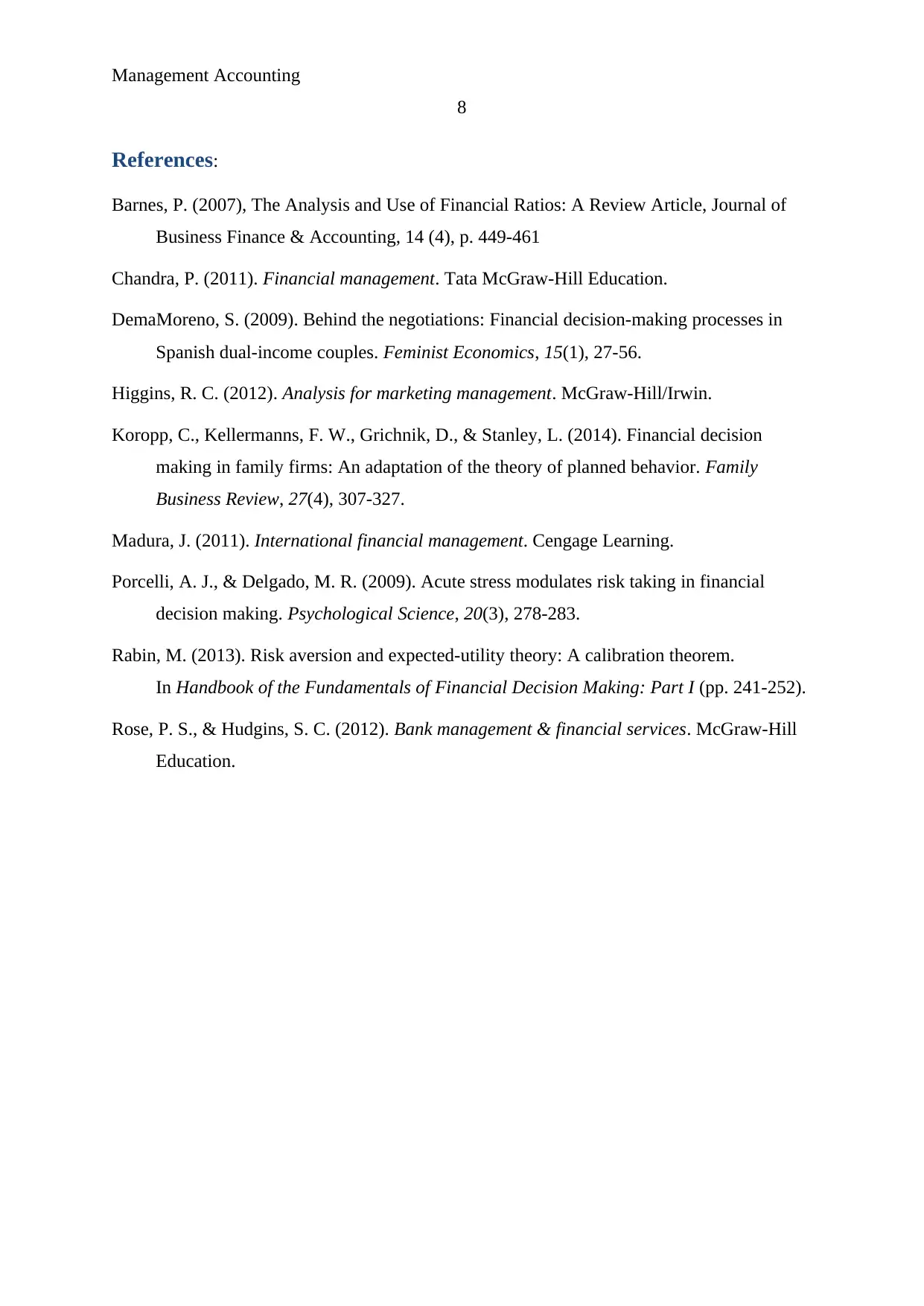
Management Accounting
8
References:
Barnes, P. (2007), The Analysis and Use of Financial Ratios: A Review Article, Journal of
Business Finance & Accounting, 14 (4), p. 449-461
Chandra, P. (2011). Financial management. Tata McGraw-Hill Education.
DemaMoreno, S. (2009). Behind the negotiations: Financial decision-making processes in
Spanish dual-income couples. Feminist Economics, 15(1), 27-56.
Higgins, R. C. (2012). Analysis for marketing management. McGraw-Hill/Irwin.
Koropp, C., Kellermanns, F. W., Grichnik, D., & Stanley, L. (2014). Financial decision
making in family firms: An adaptation of the theory of planned behavior. Family
Business Review, 27(4), 307-327.
Madura, J. (2011). International financial management. Cengage Learning.
Porcelli, A. J., & Delgado, M. R. (2009). Acute stress modulates risk taking in financial
decision making. Psychological Science, 20(3), 278-283.
Rabin, M. (2013). Risk aversion and expected-utility theory: A calibration theorem.
In Handbook of the Fundamentals of Financial Decision Making: Part I (pp. 241-252).
Rose, P. S., & Hudgins, S. C. (2012). Bank management & financial services. McGraw-Hill
Education.
8
References:
Barnes, P. (2007), The Analysis and Use of Financial Ratios: A Review Article, Journal of
Business Finance & Accounting, 14 (4), p. 449-461
Chandra, P. (2011). Financial management. Tata McGraw-Hill Education.
DemaMoreno, S. (2009). Behind the negotiations: Financial decision-making processes in
Spanish dual-income couples. Feminist Economics, 15(1), 27-56.
Higgins, R. C. (2012). Analysis for marketing management. McGraw-Hill/Irwin.
Koropp, C., Kellermanns, F. W., Grichnik, D., & Stanley, L. (2014). Financial decision
making in family firms: An adaptation of the theory of planned behavior. Family
Business Review, 27(4), 307-327.
Madura, J. (2011). International financial management. Cengage Learning.
Porcelli, A. J., & Delgado, M. R. (2009). Acute stress modulates risk taking in financial
decision making. Psychological Science, 20(3), 278-283.
Rabin, M. (2013). Risk aversion and expected-utility theory: A calibration theorem.
In Handbook of the Fundamentals of Financial Decision Making: Part I (pp. 241-252).
Rose, P. S., & Hudgins, S. C. (2012). Bank management & financial services. McGraw-Hill
Education.
1 out of 8
Related Documents
Your All-in-One AI-Powered Toolkit for Academic Success.
+13062052269
info@desklib.com
Available 24*7 on WhatsApp / Email
![[object Object]](/_next/static/media/star-bottom.7253800d.svg)
Unlock your academic potential
Copyright © 2020–2025 A2Z Services. All Rights Reserved. Developed and managed by ZUCOL.





